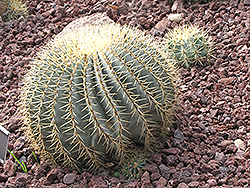Fri & Sat 8am - 8pm
Sun 8am - 7pm
Anytown, USA 12345
fax: 261.787.0463
e-mail: info@successgc.com


Plant Finder

Height: 24 inches
Spread: 3 feet
Sunlight:
![]()
Hardiness Zone: 9a
Other Names: Echinocactus glaucescens, Ferocactus pfeifferi
Description:
A slow growing, powder blue, barrel shaped cactus displaying prominent ribs adorned with cream spines; bright lemon yellow flowers from late spring to summer on mature specimens in full sun; offsets can eventually form a large colony
Ornamental Features
Blue Barrel Cactus is a member of the cactus family, which are grown primarily for their characteristic shapes, their interesting features and textures, and their high tolerance for hot, dry growing environments. Like all cacti, it doesn't actually have leaves, but rather modified succulent stems that comprise the bulk of the plant, and which are designed to hold water for long periods of time. This particular cactus is valued for its distinctive barrel shape, and usually grows as a single spiny ribbed powder blue stem. This plant has lemon yellow cup-shaped flowers held atop the stems from late spring to early summer, which are interesting on close inspection.
Landscape Attributes
Blue Barrel Cactus is a succulent evergreen plant with a characteristic upright barrel shape. It tends to grow as a solitary entity comprised of a single stem, and it doesn't usually spread laterally. As a type of cactus, it has no true foliage; the body of the plant is wholly comprised of a spiny powder blue stem which is prominently ribbed.
This is a relatively low maintenance plant, and should never be pruned except to remove any dieback, as it tends not to take pruning well. Deer don't particularly care for this plant and will usually leave it alone in favor of tastier treats. Gardeners should be aware of the following characteristic(s) that may warrant special consideration;
- Insects
- Spiny
Blue Barrel Cactus is recommended for the following landscape applications;
- Mass Planting
- Rock/Alpine Gardens
- General Garden Use
- Container Planting
Planting & Growing
Blue Barrel Cactus will grow to be about 24 inches tall at maturity, with a spread of 3 feet. It is often grown as either a solitary specimen or in combination with other complementary plants as part of a garden composition. It grows at a slow rate, and under ideal conditions can be expected to live for 40 years or more.
This plant should only be grown in full sunlight. It requires an extremely dry, well-drained growing location, and will usually die in standing water. It is considered to be drought-tolerant, and thus makes an ideal choice for a low-water garden or xeriscape application. Like most succulents and cacti, this plant prefers to grow in poor soils and should therefore never be fertilized. It is not particular as to soil pH, but grows best in sandy soils. It is somewhat tolerant of urban pollution. This species is not originally from North America. It can be propagated by division.
Blue Barrel Cactus is a fine choice for the garden, but it is also a good selection for planting in outdoor pots and containers. It can be used either as 'filler' or as a 'thriller' in the 'spiller-thriller-filler' container combination, depending on the height and form of the other plants used in the container planting. It is even sizeable enough that it can be grown alone in a suitable container. Note that when growing plants in outdoor containers and baskets, they may require more frequent waterings than they would in the yard or garden.
